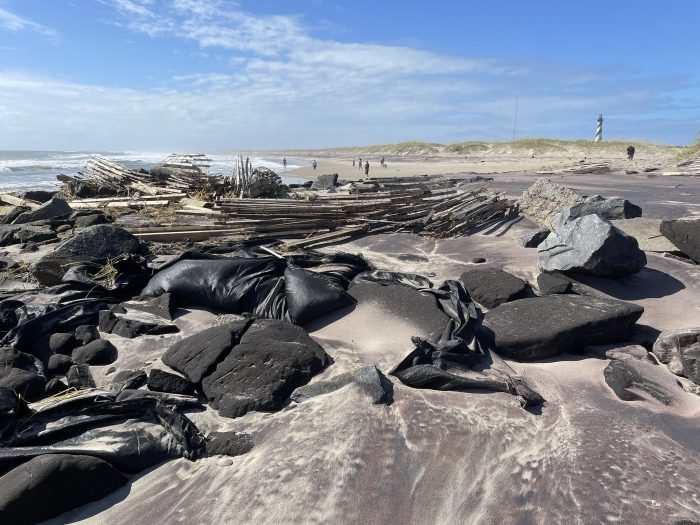
It has been more than two weeks since a visible fuel slick was reported by local surfers at Old Lighthouse Beach in Buxton, and roughly a week since word spread that there were no immediate plans in place to address the escalating problem.
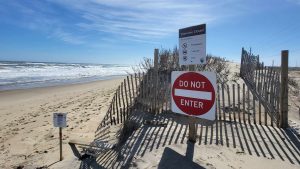
Since then, local residents and officials have been sounding the alarm to draw attention to the issue and to encourage the government stakeholders involved to find a solution now, instead of letting conditions reach a crisis level, forcing a response.
County Commissioner Danny Couch is working with the six other members of the Dare County Board of Commissioners to shine a national light on the issue, and the Cape Hatteras National Seashore (CHNS) published a new web page that explains the history of Buxton Beach, and the current status of the closed shoreline.
The U.S. Coast Guard (USCG) has also been actively conducting a Comprehensive Environmental Response, Compensation, and Liability Act (CERCLA) investigation at the site to evaluate the presence of non-petroleum contaminants. The investigation has been underway for several months and is expected to conclude during the summer of 2024.
These are all solid steps, but massive federal and/or state resources will be required to tackle a difficult situation without an easy solution.
A brief background on the current problem
Since the closure of a roughly 500-yard stretch of Buxton Beach following the offshore appearances of Tropical Storm Idalia and Hurricane Franklin in late August 2023, there have been persistent reports of a fuel smell in the area.
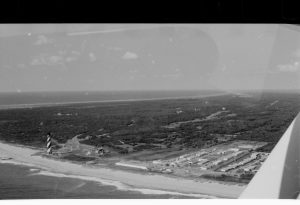
Infrastructure from the former Buxton Naval Facility was also exposed during these storms, (namely the remnants of the Terminal Building and the former Driftwood Club), along with a collection of pipes, cables, and other miscellaneous but permanently stuck-in-the-sand debris.
As Island Free Press reported on Feb. 19, it was initially believed that remediation efforts would be conducted under the U.S. Army Corps of Engineers’ FUDS Program. FUDS stands for Formerly Used Defense Sites, and the program addresses environmental liabilities that resulted from Department of Defense activities at eligible properties.
Because the site was an active naval base from 1956 to 1982, before it was transferred to the USCG, the common perception was that the U.S. Army Corps of Engineers (USACE), potentially working with the USCG and the N.C. Department of Environmental Quality (NCDEQ), would address the issues as the agencies had in the past.
Unfortunately, after a lengthy investigation, the USACE said the source of the fuel contamination – evident by both the sporadic smell as well as washed-up peat sediments that routinely tested positive for petroleum – was not able to be identified.
And without a confirmed location as to where the petroleum originated, action can’t be taken at Buxton Beach using FUDS funding, according to the FUDS program rules.
“We (USACE) have conducted subsurface investigations at various locations on the beach and have not found a source of petroleum,” stated Cheri Pritchard, Media Relations Chief for USACE Savannah District in an email to Island Free Press on Feb. 12. “Unfortunately, in the absence of a source, the FUDS program cannot take any action at the site.
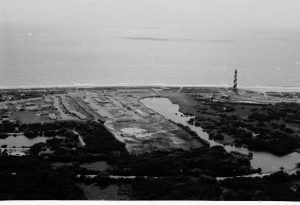
“USACE FUDS needs to confirm there is a source associated with Navy activity at the site for this matter to fall within the scope of the FUDS program.”
In addition, while the USACE removed exposed infrastructure along Buxton Beach in the past under a different program, the FUDS program can’t address the new infrastructure that has surfaced in the past six months, according to USACE.
“The [FUDS] program can only address issues that were a hazard at the time the property was transferred out of Department of Defense (DoD) control,” stated Pritchard. “Unsafe conditions arising after DoD jurisdiction are not eligible for FUDS action.”
Per the new CHNS web page, however, “the Corps continues to evaluate the situation and [determine] if its authorities will allow for the removal of historic building infrastructure and associated [petroleum-contaminated soils].”
So where is the fuel smell coming from, and how often does it smell?
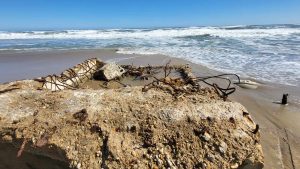
David Hallac, National Parks of Eastern North Carolina Superintendent, has been at the forefront of this issue since Idalia and Franklin scraped the Outer Banks in the fall of 2023.
“We asked our staff to go out there every day starting in September, but once the smell started getting significant – with individuals complaining of headaches – there were safety concerns of being in that area, so we stopped going there daily,” said Hallac.
Nevertheless, National Park Service (NPS) personnel routinely made visits to the closed shoreline between 46285 Old Lighthouse Road and the southernmost jetty at Old Lighthouse Beach and kept a logbook of when the fuel smell was noticeable.
“Approximately half the times we were there, we would smell an odor,” said Hallac. “On many occasions, we would find peat sediment, and multiple pieces of that sediment clearly smelled as if they had some sort of petroleum contamination. Most of these samples came back positive for petroleum contamination – and this included portions of sand, not just peat clumps.”
Most of the observations recorded by the NPS of a fuel smell, and other evidence of petroleum, stemmed from the first and third jetties at Old Lighthouse Beach, as well as from the recently-exposed Terminal Building – a structure that was used for submarine detection while the naval base was operational.
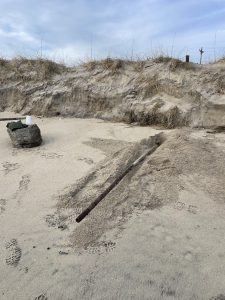
“Our staff have also observed [fuel] sheens in front of that old building,” said Hallac. “It seems like, somehow or another, something came out of that site into the ocean, to the point that surfers have seen that [sheen] near the jetty itself.”
Hallac notes that, in the now visible mess of deteriorated infrastructure, there is a steel pipe 1-3 inches in diameter which is adjacent to the recently exposed Terminal Building. “Based on odors coming out of the pipe and the sampling, there may be some type of petroleum there.”
But the potential source of fuel sheens and smells is likely not just limited to the Terminal Building alone, simply because it’s everywhere.
“There is also clearly petroleum sediment in the area,” adds Hallac. “So where did it come from?”
One of the issues with identifying a precise petroleum source is that the sporadic fuel smells and sheens are very much influenced by constantly changing ocean conditions, and especially the tides.
Per months of NPS reports, the stench seems to be most prevalent during high tides, so it could be incredibly noticeable in the morning, but gone by the afternoon.
Regardless of when the fuel smell occurs, however, dissecting how petroleum infiltrated Buxton Beach tends to lead to a logical conclusion.
“It could be the U.S. Coast Guard, but we’re not aware of any fuel spills that they had in this location,” said Hallac. “Could it be from a shipwreck? Sure, that’s a possibility, but would it land in this one spot out of 75 miles of [National Seashore?] Unlikely.
“Did the Navy have fuel spills here? Yes. Did the Navy have above and below-ground fuel tanks here? Yes. Did the Corps try to remove fuel here? Yes. Did the Corps’ reports say they removed all the fuel here? No.”
4,000 tons of petroleum-contaminated sediment were removed from the area prior to 2005. Lifelong local residents like Danny Couch recall seeing gallons and gallons of fuel pouring into the ground during routine vehicle fill-ups in the 1970s when the military base was active.
“There appears to be a weight of evidence that this is connected to that [naval] site and the historic contamination,” said Hallac. “For decades, they have been performing remediation contamination. It seems like more work is necessary to complete the job.”
How a Buxton Beach cry for help is spreading
Local professional surfer Brett Barley has roughly 31,000 followers on Facebook and nearly 100,000 fans on Instagram.
When lifelong visitor Susan Sigmon noticed Barley’s February 13 Facebook post about a fuel-drenched surfing session on Buxton Beach, when even a shower couldn’t remove the lingering petroleum smell, she took action.
Sigmon has been a regular Buxton Beach visitor for more than 50 years.
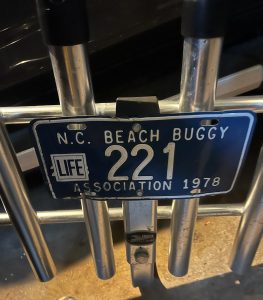
“I hear all kinds of people say, ‘I love the Outer Banks,’ so it almost loses its meaning after a while… But I love the Outer Banks, and especially Buxton,” she said. “I’m an avid surf fisherman, I love birding, I love the sunrises and the sunsets, and even the storms – I love it all.”
After purchasing a home a few years ago on nearby Cottage Avenue in Buxton, Sigmon gets to spend several months a year in Buxton these days, usually in the fall and spring.
Sigmon doesn’t label herself as a local, but she has always felt like a part of a community and has deep roots that clearly indicate she is more than just the casual Buxton vacationer.
“My dad and Danny Couch’s dad were friends,” she said. “My dad was one of those first waves of North Carolina Beach Buggy Association members, so his [member number and] license plate number was 221… I display that 221 license plate proudly on my vehicle, every time I drive out to the beach.”.
Because of a decades-long relationship, Sigmon reached out to her local Hatteras Island County Commissioner – Danny Couch – almost immediately after noticing Barley’s social media post.
She remembers seeing the expansive military base while it was active during a Cape Hatteras Lighthouse climb in 1969, and being surprised at the sight. “It was an area that was definitely off limits, but I remember that you could look down from the lighthouse and see it. I remember being surprised that it even existed, and thinking, ‘Wow, what’s that?'”
Prior to Aug. 2023, she would occasionally see patches of exposed infrastructure on the Buxton shoreline, but nothing that warranted any worry. “I remember seeing something sticking out at times, but you always see shipwrecks sticking out, so it wasn’t even on my radar that this was something from the old Navy or Coast Guard Station.”
Then, in the fall of 2023, Sigmon saw the news articles about Buxton, and the petroleum-related beach closure.
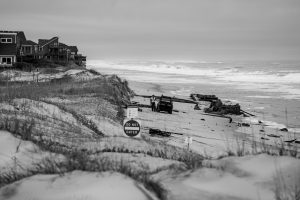
“I had heard about the beach closure and didn’t think that much about it at the very beginning,” she said. “But I follow Brett Barley, saw his post, and then I thought, ‘that’s not a half mile from my home, and what does that mean?’
“That’s when I thought, this just can’t be. It’s a National Seashore for heaven’s sake. Why are we letting this happen to a National Seashore?”
Sigmon was arguably one of the first Buxton folks to reach out to Couch with a potential solution.
She wanted to start a letter-writing campaign to U.S. and state representatives to help spread the word.
“I asked [Couch] if there is any way he could provide a list of the players, and their contact information, and let’s unleash that,” she said. “If we could have the names of the pertinent agencies and make them available, maybe we can really start giving this issue the pressure that’s needed.
“I don’t have any beef with anyone. I know there are good, smart, caring people involved. I also understand there are rules in place, but the reality is that this is having a negative impact on our environment, and we have to act quickly,” she added. “It takes a lot of energy to get things moving and it’s important that we act with a sense of urgency. I live a half mile away, so I’m worried personally, but it’s bigger than me for sure.
“My frustration is that we have the framework to resolve this, we just need a lead agency to own it and act. We need to quit pointing fingers. There just needs to be action at this point.”
Troy Kingsbury is the head of an eight-member team that purchased a large section of the former U.S. Coast Guard housing – now known as Cottages on the Cape – in July 2022.
There are 43 total homes on the 8.13-acre site, and for most of their 30-year lifespan, they were used as long-term housing.
First, the buildings solely served as housing for the U.S. Coast Guard, but they eventually became rentable units for local residents and Coast Guard personnel.
When Kingsbury and his group purchased the property, they knew a bit about this history and the work that would be involved in transforming the site. Prior to the purchase, the group performed an expansive environmental study – a perquisite of the bank to secure the loan – and the results surprisingly came back clear of any issues.
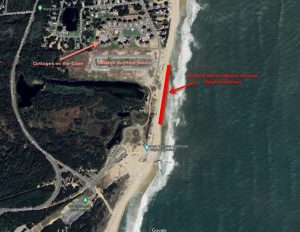
The 43 homes are divided into 2-4 bedroom units, and initially, the plan was to completely renovate and overhaul the properties and turn them into weekly vacation rentals, which was the most obvious path to recouping the costs of purchasing the property.
But there were still 14 long-term renters at the time of the 2022 purchase, making it one of the larger long-term housing clusters on Hatteras Island.
And after Kingsbury became more ingrained in the Old Lighthouse Road neighborhood, visiting the area from his home in Richmond, Virginia, the plans changed.
“Obviously, it was going to be more profitable for this to be all short-term rentals,” he said. “But as I started spending more time down here and started meeting the long-term tenants that we had, I learned about the massive housing shortage. We didn’t realize that from afar.
“These tenants work and live here, and they would have had to move off the island. After that first trip, I called my partners and said, ‘We’re keeping all the long-term tenants.’ When you look at it on paper, it doesn’t make financial sense. But we have to be good stewards down here.”
Kingsbury and his partners have done a lot of work to keep the long-term units safe and maintained, and to transform the new weekly rental units into enticing vacation destinations.
The completely renovated vacation rentals are located in the heart of Buxton. They are close to restaurants and shops, and have one of the best views of the Cape Hatteras Lighthouse on the island. While a stretch of the adjacent beach is closed due to the ongoing issues, it’s a small area, and the Cottages on the Cape are still a few minutes’ walk away from Buxton shorelines that have not been impacted by recent environmental changes.
But Kingsbury is understandably concerned that recent attention on Buxton Beach is building a bad reputation. Since the publication of the initial Island Free Press article, they have had two cancellations by visitors, solely because of this negative exposure.
It’s a double-edged sword for Kingsbury and his partners. The beach that is closest to the Cottages at the Cape is safe and wide open, but resolving the nearby environmental issues has suddenly become a top priority.
“If someone’s up in New Jersey or something, and all of a sudden they hear about it or read about it, they will likely think, ‘Oh my God, we can’t go on the beach. It’s polluted,’” he said, “And suddenly, we have fewer visitors to one of the most popular beaches on the Outer Banks, and that trickles down to businesses.”
Despite the potential for reputational damage, Kingsbury has become actively involved and is one of many who contacted local and state officials to find out how to help.
“In the end, it’s more important to get attention to the issue and get it fixed,” he said. “I don’t think it’s going to be a quick fix. Especially if there is petroleum leaking, but someone needs to step up and take the lead. We will do what we can to help, but we just need someone to take the lead and let us know how we can help.”
Deb Hoyt has a greater familiarity with Buxton Beach, and lives about a mile from the closed stretch of contaminated shoreline.
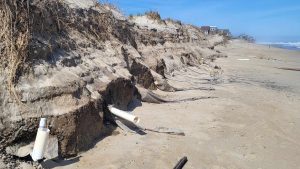
“We’ve been here [permanently] a little less than four years, but my husband has been coming here for 40 or 45 years,” she said. “We love the area. It’s precious to us, and it’s obviously precious to the people who were born and raised here.”
Hoyt has a reliable routine where she walks roughly 3.5 miles from her home on Flowers Ridge Road, following a consistent route that takes her to Old Lighthouse Beach and back. As such, she is an inadvertent monitor of how the shoreline has changed over the past few months.
“We always take an opportunity to take a look at the ocean and the beach, and that’s where all the structures are. We see them every day now,” she said. “Until last fall, you might have seen bits and pieces after a storm. But now, you can see two large structures almost the size of minivans.”
The fuel smell has infiltrated her routine walks as well.
“The first time we noticed the smell was at the end of August or early September. We’ve smelled it more than once since then,” she said. “You could smell it from behind the dunes area as you’re walking through the [Buxton Day Use Area] parking lot.”
She also started to notice what she initially thought were “fish slicks,” or indications that there were schools of small silvery fish in the ocean waters, in the past month. She eventually realized it was fuel.
“I thought the ‘fish slicks’ were very unusual when we saw them around Valentine’s Day,” she said. “Now, I know what it actually was.
“As a resident and a concerned citizen, we’re worried for our neighbors and our small business owners. That’s such a part of the fabric of our community, and any tainting of the reputation of this area can have a trickle-down effect on the neighbors who make their income here.”
There’s a justifiable pattern of worry
When environmental issues like the ones at Buxton Beach arise, there is justifiable concern that headlines swarming around the issue will derail vacationers.
Unfortunately, when it comes to the Outer Banks, regional, national and even international headlines are inherently attracted to the catastrophic, as opposed to the more positive stories about our islands.
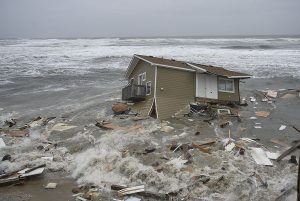
Consider the three home collapses in Rodanthe in 2022. A video posted by CHNS of the second of two home collapses that occurred on May 10 went viral, with more than 30 million views across social media within weeks of the destruction.
Nevertheless, the Cape Hatteras National Seashore had 2,826,169 visitors in 2023 – the fourth busiest year on record – which virtually matched 2022’s total visitation of 2,862,844.
It is time to sound the alarm about Buxton Beach, and the precedent has been set.
From regional media coverage, to folks like Sigmon who are initiating letter-writing campaigns, it’s fine to add a voice to the growing consensus of “This is not right and needs to be fixed.”
Every person Island Free Press has interviewed so far who has been personally affected by the situation believes the end-game goal is not pointing fingers, but fostering cooperation.
It’s not the time for blame, but it is the time for action.




Joy, the comments and thrust of this article are spot on, in my opinion. Even if cleaning up this environmental hazard is not directly within one agency or department’s guidelines, everyone should relax the rules a little bit and do what they can to clean up the problem for the greater good. We don’t hear much about the greater good these days, but this situation is a perfect example of how to put that phrase into action,.